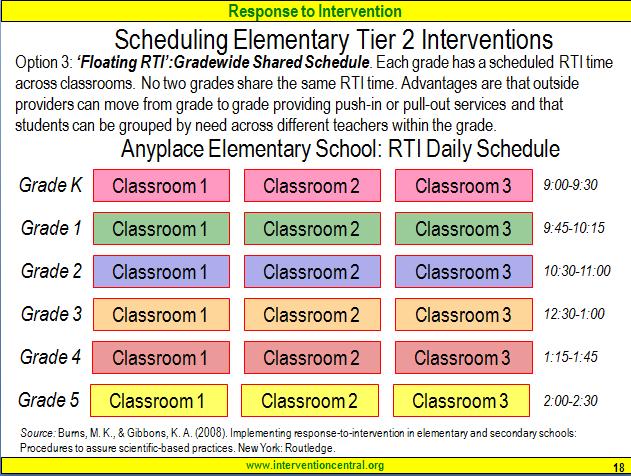A new, streamlined version of Intervention Central is coming in December 2023. The new site will eliminate user login accounts. If you have a login account, be sure to download and save any documents of importance from that account, as they will be erased when the website is revised.
Main menu
RTI in a Time of Staff Cuts: Ideas to Provide Quality Interventions With Less…
The recent Great Recession has resulted in significant budget cuts for school districts across America. In the face of diminished resources and staff cutbacks, many schools are wondering how they will be able to move forward in implementing RTI. Unfortunately, funding projections in the majority of states suggest that reduced school budgets and staffing levels may become ‘the new normal’ for at least the next two to three years—if not longer.
While there are no easy answers to the problem of RTI underfunding and staff downsizing, schools can consider creative strategies to allow them to continue to deliver intensive student interventions of high quality. Such ideas would include expanding the pool of non-instructional personnel (including volunteer tutors), adopting schedule changes that make more efficient use of existing staff, and allocating scarce teaching resources to those early grades where those resources will have maximum long-term impact in promoting student achievement.
- Special-area and non-instructional personnel. Support staff members (e.g., school psychologists, guidance counselors), special-area teachers (e.g., art, music, physical education), and paraprofessionals (e.g., teaching assistants) with available time in their schedule can all help to deliver interventions. A useful exercise for the school is to review the building personnel roster and compile a list of those staff with non-instructional or special-area assignments. The work schedules and duties of each staff member on the list would then be reviewed to determine if that staff member has any open time to deliver small-group or individual interventions.
- Adult volunteers. Schools can develop a cadre of adult volunteers as another means to expand the interventionist pool. Parents, community-service organizations, and graduate training programs that seek school placements for their students are all potential sources for adult volunteers. The HELPS program (Begeny, 2009) is an example of a free, effective intervention package to promote reading fluency that could be used by both non-instructional school personnel and volunteer tutors. Training and teaching materials for HELPS are available at http://www.helpsprogram.org.
- Public-school students. An underused source of intervention help that schools should not overlook is their own students, who can serve as cross-age or same-age peer tutors. Cross-age peer tutors are older students who work with younger children. An example of a cross-age peer tutoring program is described in the free Kids as Reading Helpers manual (Wright, 2004), available at http://www.interventioncentral.org/index.php/downloads. Same-age tutors are usually recruited to work with other students in the same classroom or grade. One well-known evidence-based program that uses same-age peers as tutors in reading and math is Peer-Assisted Learning Strategies (PALS) (e.g., Sáenz, Fuchs, & Fuchs, 2005; What Works Clearinghouse, 2007).

References
-
Begeny, J. C. (2009). Helping Early Literacy with Practice Strategies (HELPS): A one-on-one program designed to improve students’ reading fluency. Raleigh, NC: The HELPS Education Fund. Retrieved from http://www.helpsprogram.org
-
Burns, M. K., & Gibbons, K. A. (2008). Implementing response-to-intervention in elementary and secondary schools. Routledge: New York.
-
Foorman, B. R., Breier, J. Il, & Fletcher, J. M. (2003). Interventions aimed at improving reading success: An evidence-based approach. Developmental Neuropsychology, 24, 613-639.
-
Sáenz, L. M., Fuchs, L. S., & Fuchs, D. (2005). Peer-Assisted Learning Strategies for English language learners with learning disabilities. Exceptional Children, 71(3), 231–247.
-
What Works Clearinghouse. (2007). WWC Intervention Report: Peer-Assisted Learning Strategies (PALS). Retrieved from http://ies.ed.gov/ncee/wwc/pdf/WWC_PALS_071607.pdf
-
Wright, J. (2004). Kids as reading helpers: A peer tutor training manual. Retrieved from http://www.interventioncentral.org/index.php/downloads
